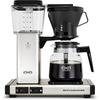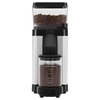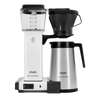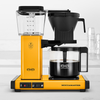My Honest Review of the Most-Hyped Coffee Maker of All Time
Celebs, chefs, and designers sing its praises.
Published Mar 25, 2024 1:05 AM
We may earn revenue from the products available on this page and participate in affiliate programs.
In some ways, each coffee tool I own has marked a time in my life. A Bodum French press was my introduction to the at-home caffeine game. Fast-forward to an Aeropress, gifted to my husband and me for our engagement. The Baratza Encore grinder that we upgraded to after our wedding. A Chemex as we settled into our first apartment, closely followed by a Fellow gooseneck kettle. A U-turn back to the Aeropress for some time, and an acquisition of a Comandante hand grinder. Then a leap forward to what has become one of my favorite kitchen products ever: Technivorm’s Moccamaster. (Our countertop has since collected a Gaggia espresso maker and all its trappings, but that’s besides the point.)
Technivorm Moccamaster KB
As a design editor, I can’t help but be drawn to domestic objects that not only work well but look really good, too. First spotted in a coffee-loving friend’s home many years ago, I initially coveted this chic architectural brewer for its perennially stylish utilitarian form, range of colors, and attractive decanter. It’s the kind of product you want to put on display, not hide away in a cupboard. We picked one up during the early, no-contact days of the pandemic and haven’t stopped brewing with it since. But don’t just take it from me. Gwyneth Paltrow stocks her Montecito guesthouse with one, and cookbook author Dan Pelosi swears by his (peep a bright orange frame in the background of his portrait). There’s even a darling baby pink version in the kitchen of this Australian creative couple’s home.
A little background: The Moccamaster has been in production in the Netherlands since 1969, five years after the brand Technivorm—appropriately named by combining the Dutch words techniek and vormgeving (“form” and “function”)—was founded. The company started out by making other functional home items (think: step ladders and shelving systems) in the mid-1960s. This then evolved into a coffee grinder, which spurred Dutch coffee brand Douwe Egberts to collaborate with Technivorm on a machine. After refining the design, the base KB model went into production in the late ’70s and has hardly changed since. It’s still made today by hand in Amerongen, like the rest of its products.
In addition to aesthetics, the Moccamaster produces extremely good coffee, better than any other drip I’ve tried. That’s partially because of its manual-adjust system, with which you can control the brewing speed through the basket or stop it entirely (we tinker with this part, but you don’t need to). It’s also due to a copper boiling element that rapidly heats the water and holds it at just the right temperature for extracting coffee grounds. A hot plate keeps it there and shuts off after 100 minutes for safety purposes, more than enough time to get through every cup, or we just flip it back on. Other things I love about the Moccamaster are that it brews quietly and quickly, is built from metal and BPA- and phthalate-free plastics, and comes with a glass carafe. Various versions of decanters, from thermal pourers to a squat, cylindrical option abound. A big bonus: Each machine comes with a five-year warranty, and the brand will repair yours for life.
Compared to other makers, the Moccamaster isn’t a budget pick. No matter which way you slice it, you’re looking at $330. There are many imitators of the style, of course, including Cafe’s version and Zwilling’s take, which are cheaper. Other design-y coffee makers include Smeg’s retro style, Alessi’s Plissé elegant shape, and Bodum’s Technicolor option, which is a MoMA Design Store exclusive (and under $100). But while it might not be an impulse buy, the Moccamaster is the most timeless, durable, and quality drip brewer on the market. This one will always have a place in my home, no matter what era I’m in.






